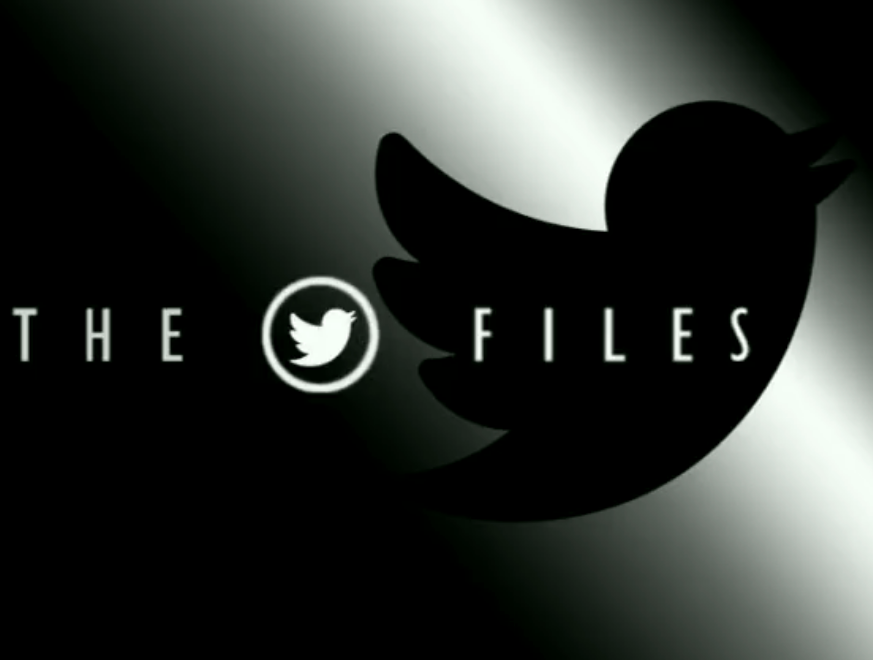

News
Elon Musk’s Twitter Files reveals former executives’ abuse of power, trust & safety
Elon Musk’s Twitter Files revealed quite a bit of detail about the former executives’ abuse of power while running the platform. In November, Elon Musk promised to release evidence of Twitter’s suppression of free speech and, on Friday, announced that he would unveil Twitter’s role in suppressing the Hunter Biden laptop news.
Elon Musk announced earlier on Friday that there would be a live Q&A, and we’ll update here when it goes live.
Here we go!! 🍿🍿 https://t.co/eILK9f3bAm
— Elon Musk (@elonmusk) December 2, 2022
In his thread, Taibbi said that the Twitter Files “tell an incredible story from inside one of the world’s largest and most influential social media platforms.” He began by highlighting Twitter’s early days as a potential tool for enabling mass communication, “making a true real-time global conversation possible for the first time.”
He then shared that some of Twitter’s first tools for controlling speech were designed to combat spammers and financial fraudsters, but slowly over time, Twitter’s staff and executives began to find more users for the tools. “Outsiders began petitioning the company to manipulate speech as well,” Taibbi tweeted, adding that it was just a little at first, then more often, and then constantly.
9. Celebrities and unknowns alike could be removed or reviewed at the behest of a political party: pic.twitter.com/4uzkHnQ65E
— Matt Taibbi (@mtaibbi) December 2, 2022
In the tweets above, Taibbi shared screenshots documenting that requests from “connected actors to delete tweets were routine.” Executives would write one another statements such as “Move to review from the Biden team.” and another one would reply, “handled.”
In addition to that, both celebrities and “unknowns” could be removed or reviewed “at the behest of a political party.”
Taibbi noted that both parties, such as the Trump White House and the Biden campaign, had requests received and honored, but the system wasn’t balanced. Instead, he said, it was based on contacts.
“Because Twitter was and is overwhelmingly staffed by people of one political orientation, there were more channels, more ways to complain, open to the left (well, Democrats) than the right.”
Taibbi shared a link with that statement from Open Secrets, which showed Twitter’s contributions to politicians. Following that, Taibbi shared more documents noting that the slant in content moderation decisions is visible and is the assessment of multiple current and high-level executives.
The Twitter Files, Part One: How and Why Twitter Blocked the Hunter Biden Laptop Story
In Part Of the Twitter Files, Taibbi started with the October 14, 2020, New York Post article titled BIDEN SECRET E-MAILS. “Twitter took extraordinary steps to suppress the story, removing links and posting warnings that it may be ‘unsafe.’ They even blocked its transmission via direct message, a tool hitherto reserved for extreme cases, e.g. child pornography,” Taibbi wrote.
Taibbi shared that Twitter locked White House spokeswoman Kaleigh McEnany out of her account for tweeting about the story, which prompted a letter from the Trump campaign staffer, Mike Hahn, who said, “At least pretend to care for the next 20 days.”
In response to that, Caroline Strom, Twitter’s public policy executive, sent out a “polite WTF query.” Taibbi noted that several employees picked up on the tension between the comms and policy teams and the safety and trust teams. The former had either little or less control over moderation.
“Strom’s note returned the answer that the laptop story had been removed for violation of the company’s “hacked materials” policy,” Taibbi wrote, sharing a screenshot of an email from Elaine Ong Sotto, Ops Analyst, Global Escalations Team. He also shared an archived webpage of Twitter’s Distribution of Hacked Material policy.
Continuing his thread, Taibbi pointed out that several sources heard about a general warning from federal law enforcement that summer about possible foreign hacks. He added that he hasn’t seen any evidence of any government involved in the laptop story. “In fact, that might have been the problem…”
He added that the decision was made at the highest levels of Twitter without the knowledge of Jack Dorsey, the platform’s then-CEO. Vijaya Gadde, Twitter’s former head of legal policy and trust, played a key role, Taibbi wrote.
24. “They just freelanced it,” is how one former employee characterized the decision. “Hacking was the excuse, but within a few hours, pretty much everyone realized that wasn’t going to hold. But no one had the guts to reverse it.”
— Matt Taibbi (@mtaibbi) December 3, 2022
In the next tweet, Taibbi shared an exchange between Gadde and Yoel Roth, Twitter’s former trust and safety head. Trenton Kennedy, the comms official, wrote, “I’m struggling to understand the policy basis for marking this as unsafe.”
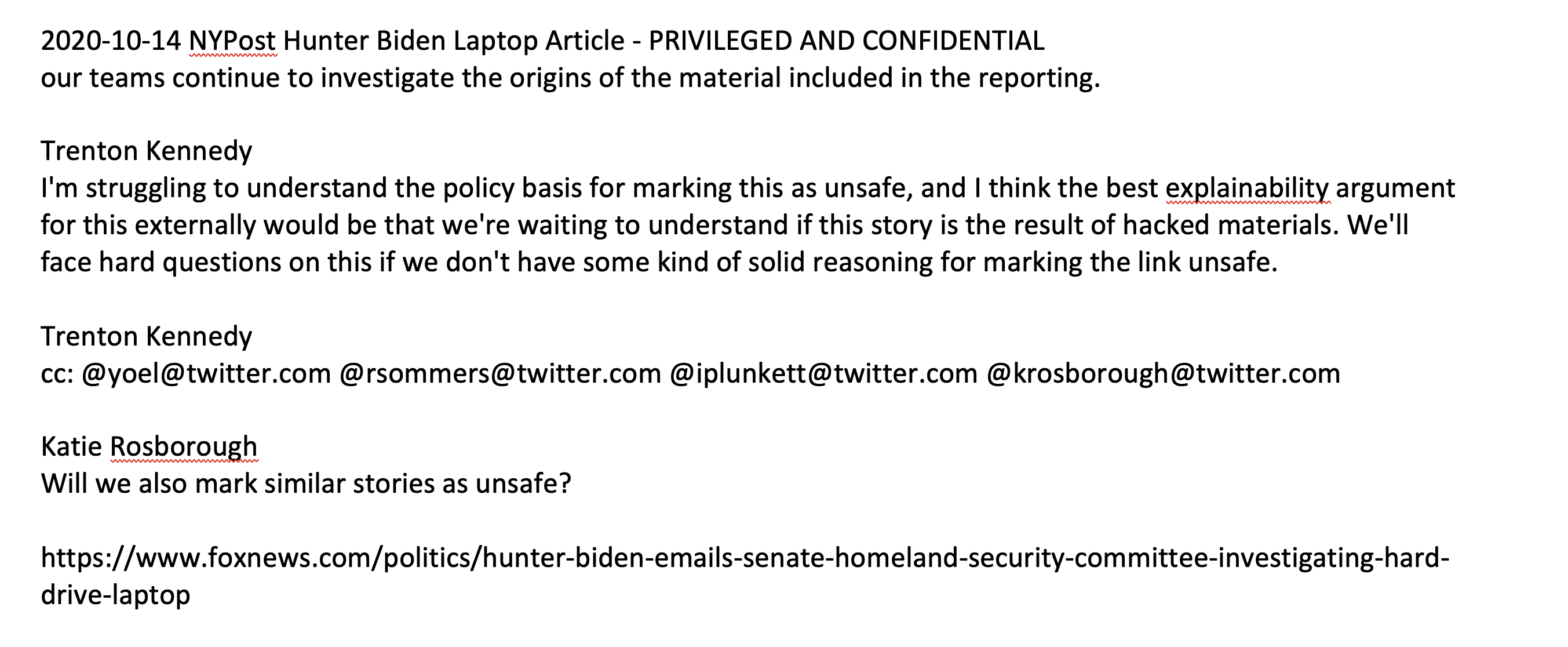
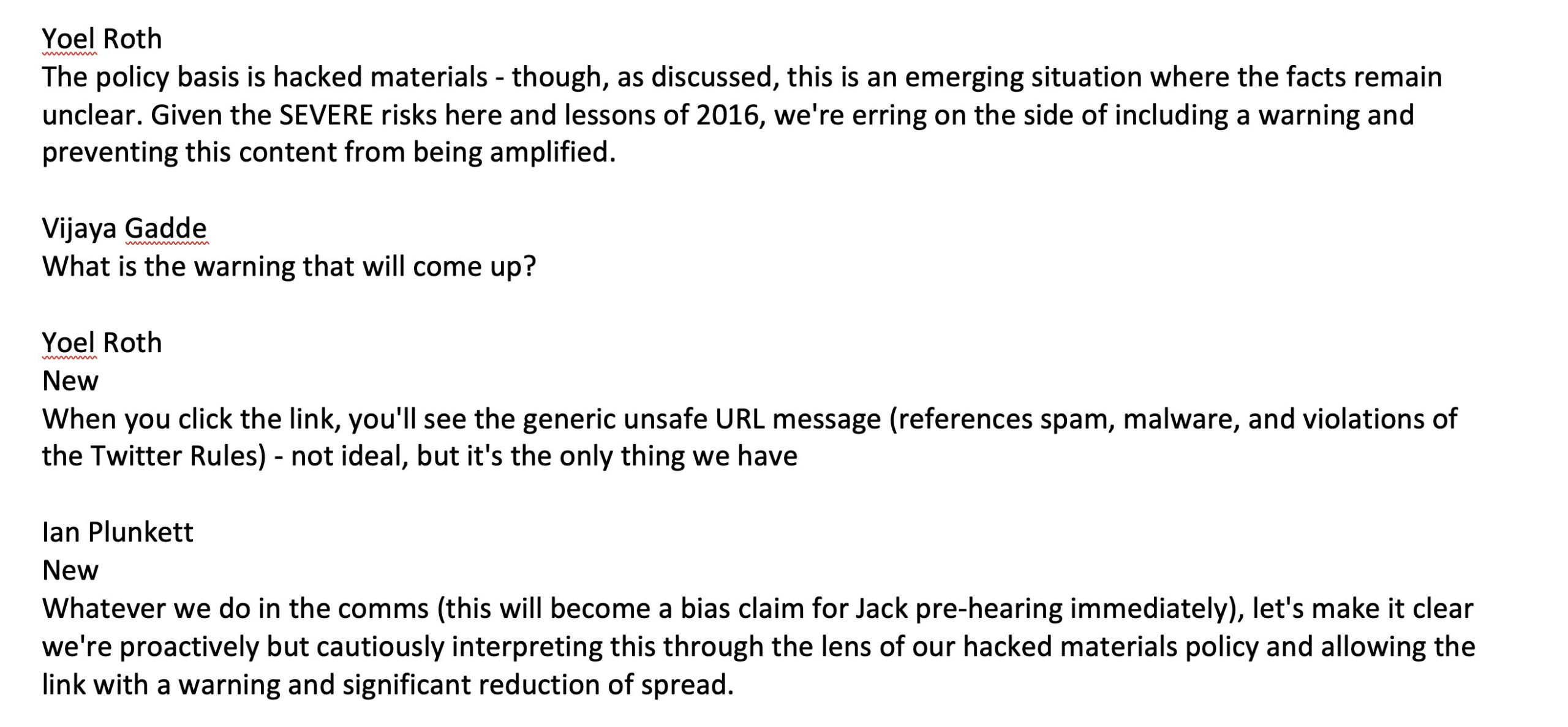
Continuing on, Taibbi noted that Twitter’s former VP of Global Comms, Brandon Borrman asked if the team could truthfully claim that this was a part of Twitter’s policy. In response, the platform’s former Deputy General Counsel, Jim Baker, “seems to advise staying the non-course because ‘caution is warranted.’

Taibbi noted that a fundamental problem with tech companies and content moderation is that there are many people in charge of speech, yet they know or care little about it. He then shared an exchange between Democratic congressman Ro Khanna and Gadde.

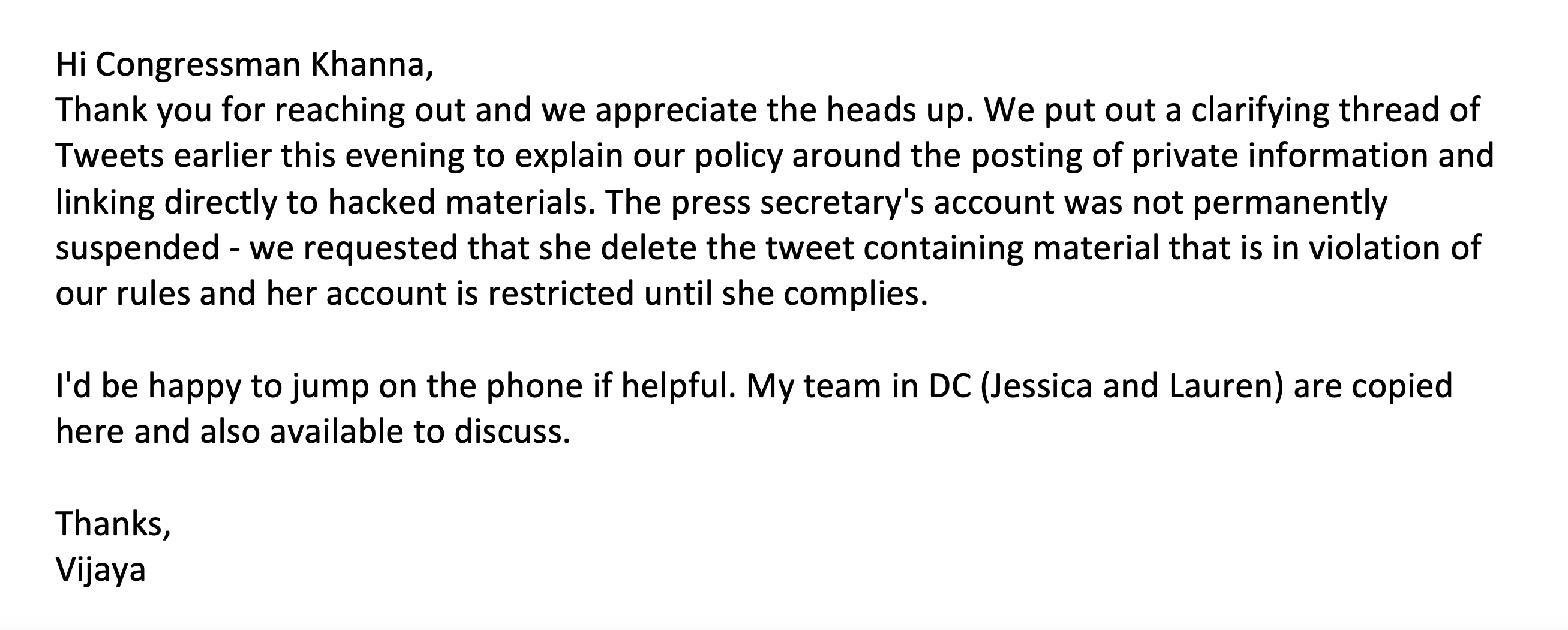
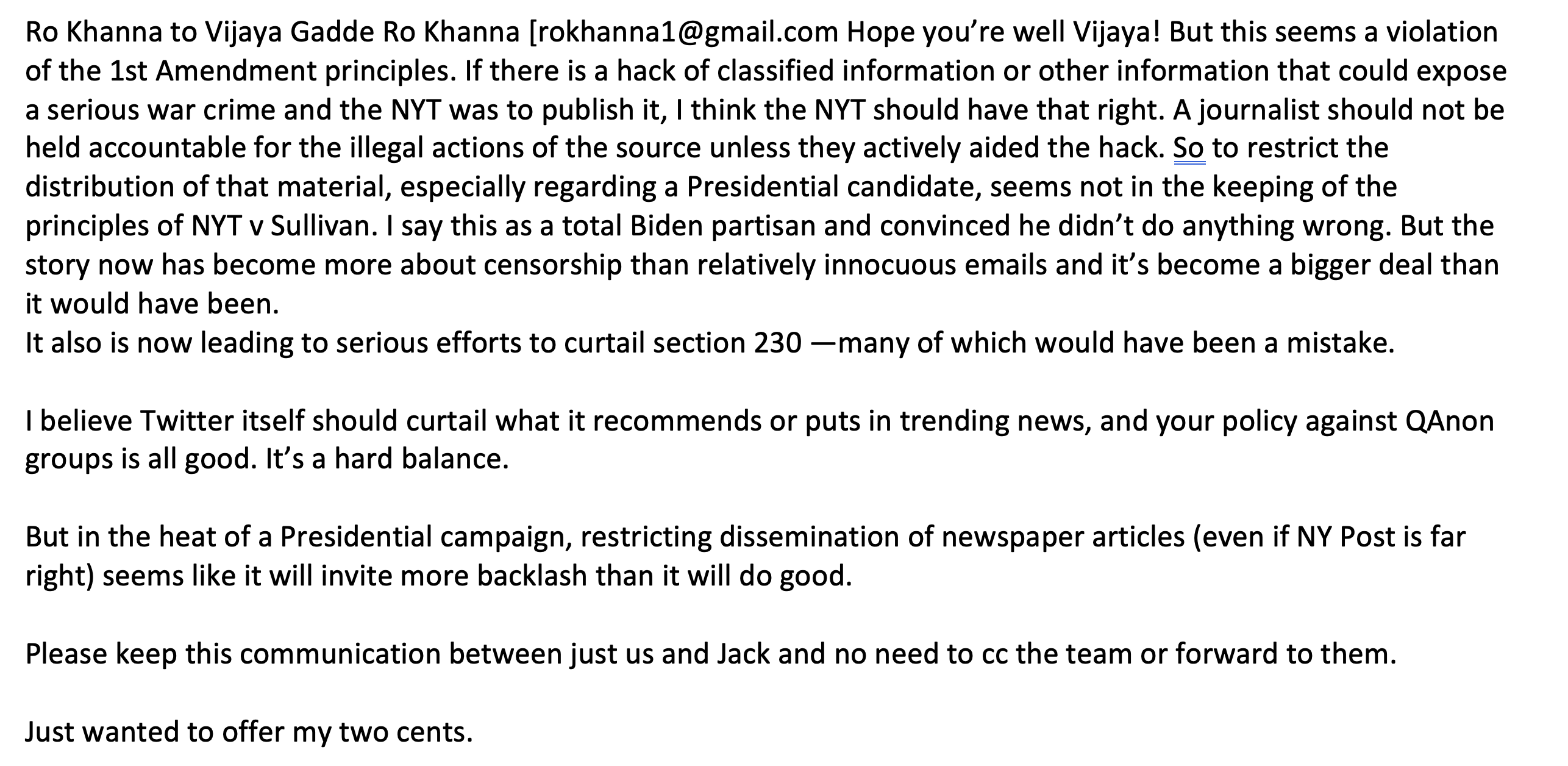
Following the above communications, Taibbi noted that the head of public policy, Lauren Culbertson received a “ghastly letter/report from Carl Szabo of the research firm, NetChoice.” The firm polled twelve members of congress:9 Republicans and 3 Democrats from “the House Judiciary Committee to Rep. Judy Chu’s office.”
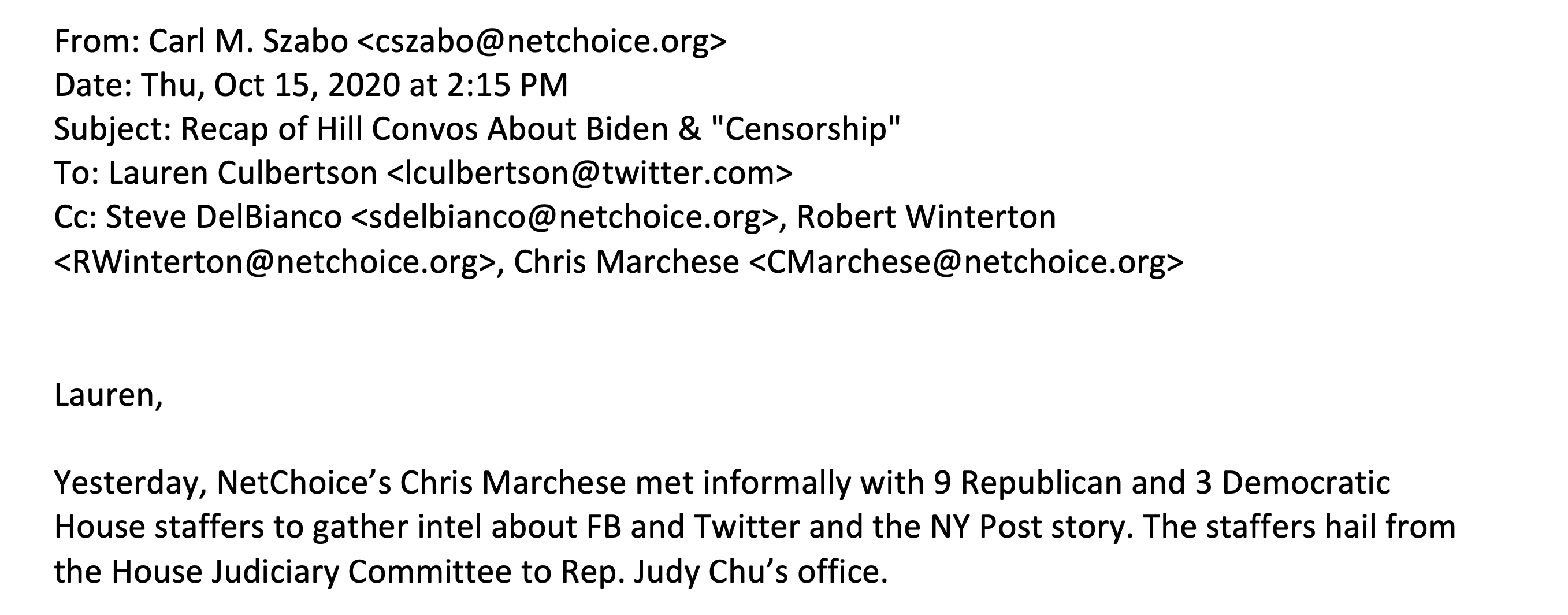
Continuing his thread, Taibbi pointed out that NetChoice informed Twitter that a “blood bath” awaited in upcoming Hill hearings. The screenshot he shared read: “High level take away–Every Republican said ‘this is a tipping point. It’s just too much.’ And both Democrats and Republicans were angry.”
The next screenshot Szabo that Taibbi shared read: “When asked just how bad this situation is, one staffer said: ‘it’s tech’s Access Hollywood moment and it has no Hillary to hide behind.’ Others were more blunt: ‘tech is screwed and rightfully so.’”
In the following screenshot, Taibbi described Szabo’s letter as containing “chilling passages relaying Democratic lawmakers’ attitudes. They want ‘more’ moderation, and as for the Bill of Rights, it’s ‘not absolute.’”
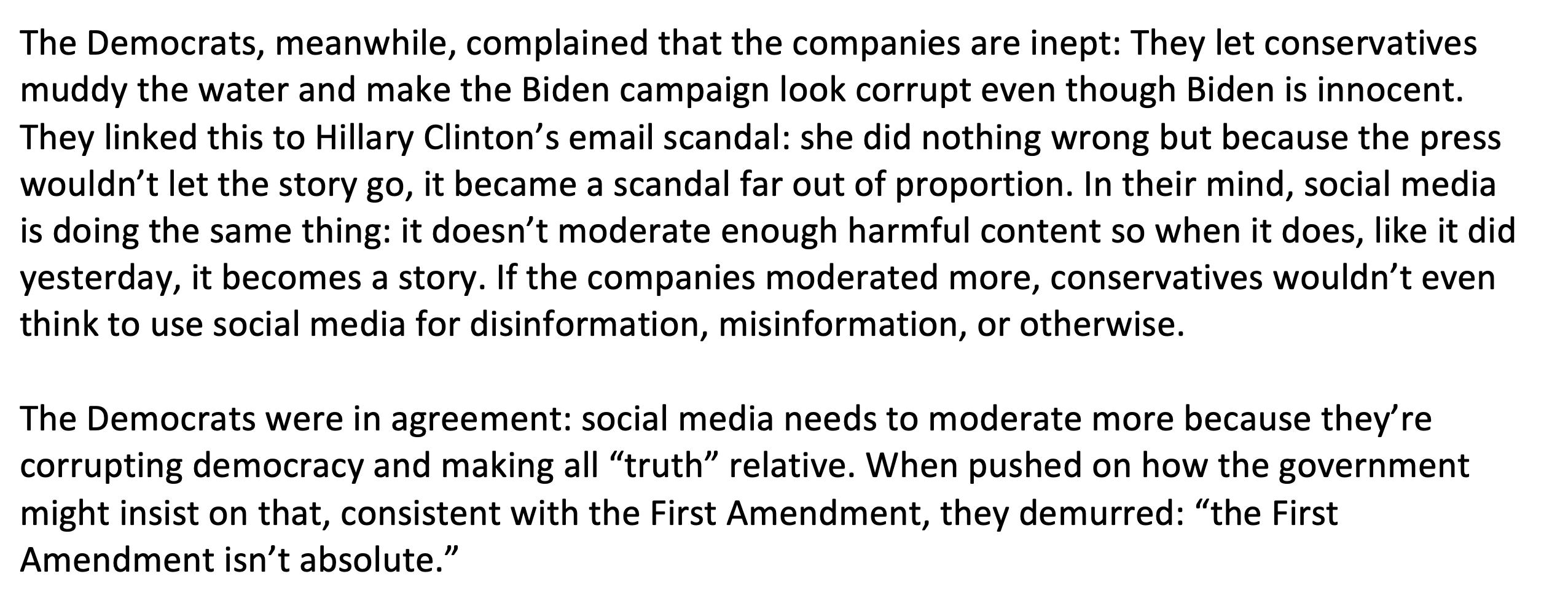
Taibbi commented that an amazing subplot of the Twitter/Hunter Biden laptop affair “was how much was done without the knowledge of CEO Jack Dorsey, and how long it took for the situation to get ‘unfucked’ (as one ex-employee put it) even after Dorsey jumped in.”
As he looked through Gadde’s emails, Taibbi noted a familiar name–his own. Jack Dorsey emailed her a copy of his Substack article blasting the incident, he noted. He added that there were multiple instances in the files where Dorsey intervened to question suspensions and other moderation actions for accounts across the political spectrum.
Your feedback is welcome. If you have any comments or concerns or see a typo, you can email me at johnna@teslarati.com. You can also reach me on Twitter at @JohnnaCrider1.
Teslarati is now on TikTok. Follow us for interactive news & more. Teslarati is now on TikTok. Follow us for interactive news & more. You can also follow Teslarati on LinkedIn, Twitter, Instagram, and Facebook.
Elon Musk
Why Tesla’s Q3 could be one of its biggest quarters in history
Tesla could stand to benefit from the removal of the $7,500 EV tax credit at the end of Q3.

Tesla has gotten off to a slow start in 2025, as the first half of the year has not been one to remember from a delivery perspective.
However, Q3 could end up being one of the best the company has had in history, with the United States potentially being a major contributor to what might reverse a slow start to the year.
Earlier today, the United States’ House of Representatives officially passed President Trump’s “Big Beautiful Bill,” after it made its way through the Senate earlier this week. The bill will head to President Trump, as he looks to sign it before his July 4 deadline.
The Bill will effectively bring closure to the $7,500 EV tax credit, which will end on September 30, 2025. This means, over the next three months in the United States, those who are looking to buy an EV will have their last chance to take advantage of the credit. EVs will then be, for most people, $7,500 more expensive, in essence.
The tax credit is available to any single filer who makes under $150,000 per year, $225,000 a year to a head of household, and $300,000 to couples filing jointly.
Ending the tax credit was expected with the Trump administration, as his policies have leaned significantly toward reliance on fossil fuels, ending what he calls an “EV mandate.” He has used this phrase several times in disagreements with Tesla CEO Elon Musk.
Nevertheless, those who have been on the fence about buying a Tesla, or any EV, for that matter, will have some decisions to make in the next three months. While all companies will stand to benefit from this time crunch, Tesla could be the true winner because of its sheer volume.
If things are done correctly, meaning if Tesla can also offer incentives like 0% APR, special pricing on leasing or financing, or other advantages (like free Red, White, and Blue for a short period of time in celebration of Independence Day), it could see some real volume in sales this quarter.
You can now buy a Tesla in Red, White, and Blue for free until July 14 https://t.co/iAwhaRFOH0
— TESLARATI (@Teslarati) July 3, 2025
Tesla is just a shade under 721,000 deliveries for the year, so it’s on pace for roughly 1.4 million for 2025. This would be a decrease from the 1.8 million cars it delivered in each of the last two years. Traditionally, the second half of the year has produced Tesla’s strongest quarters. Its top three quarters in terms of deliveries are Q4 2024 with 495,570 vehicles, Q4 2023 with 484,507 vehicles, and Q3 2024 with 462,890 vehicles.
Elon Musk
Tesla Full Self-Driving testing continues European expansion: here’s where
Tesla has launched Full Self-Driving testing in a fifth European country ahead of its launch.
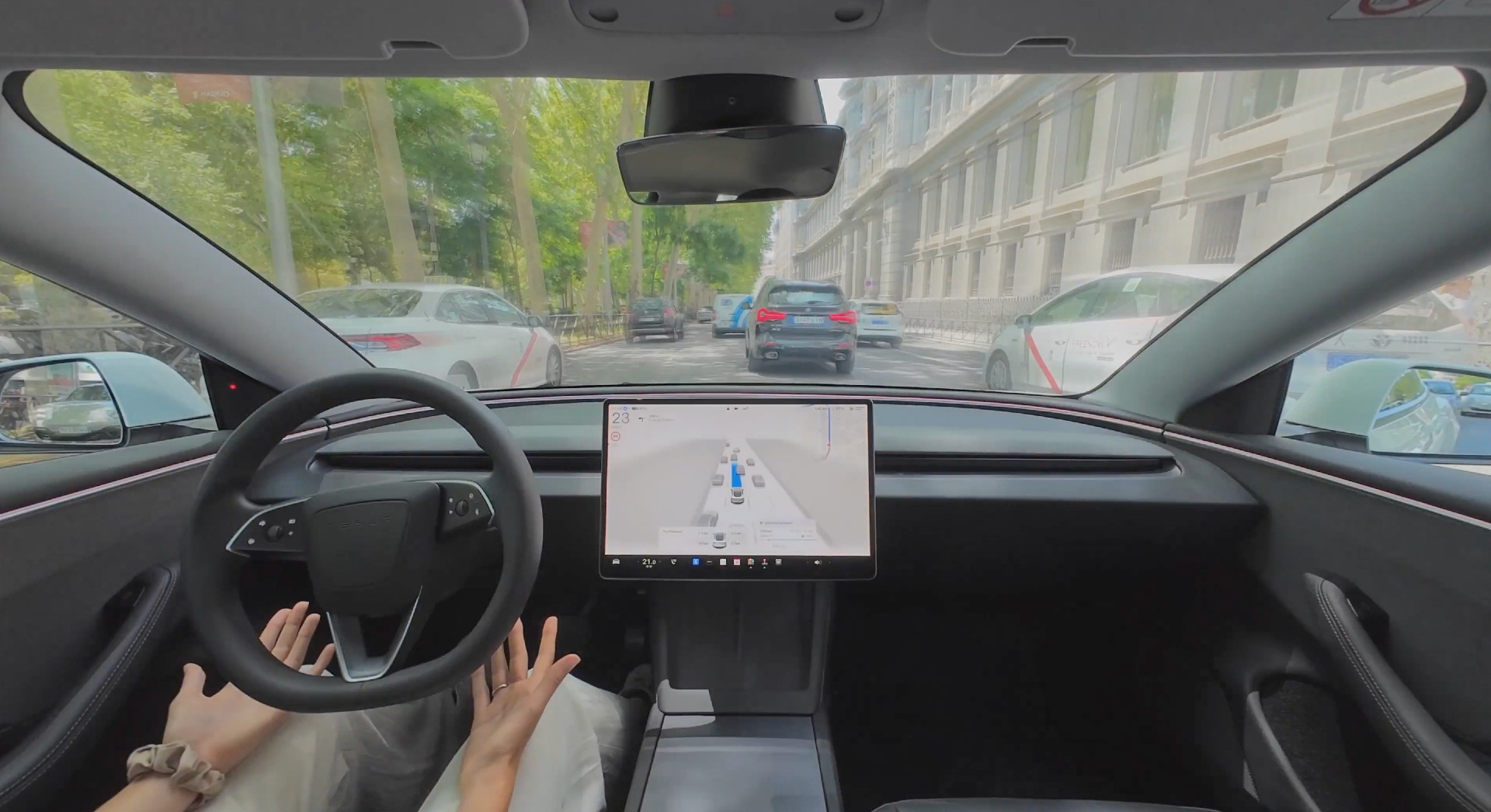
Tesla Full Self-Driving is being tested in several countries across Europe as the company prepares to launch its driver assistance suite on the continent.
The company is still working through the regulatory hurdles with the European Union. They are plentiful and difficult to navigate, but Tesla is still making progress as its testing of FSD continues to expand.
Today, it officially began testing in a new country, as more regions open their doors to Tesla. Many owners and potential customers in Europe are awaiting its launch.
On Thursday, Tesla officially confirmed that Full Self-Driving testing is underway in Spain, as the company shared an extensive video of a trip through the streets of Madrid:
Como pez en el agua …
FSD Supervised testing in Madrid, Spain
Pending regulatory approval pic.twitter.com/txTgoWseuA
— Tesla Europe & Middle East (@teslaeurope) July 3, 2025
The launch of Full Self-Driving testing in Spain marks the fifth country in which Tesla has started assessing the suite’s performance in the European market.
Across the past several months, Tesla has been expanding the scope of countries where Full Self-Driving is being tested. It has already made it to Italy, France, the Netherlands, and Germany previously.
Tesla has already filed applications to have Full Self-Driving (Supervised) launched across the European Union, but CEO Elon Musk has indicated that this particular step has been the delay in the official launch of the suite thus far.
In mid-June, Musk revealed the frustrations Tesla has felt during its efforts to launch its Full Self-Driving (Supervised) suite in Europe, stating that the holdup can be attributed to authorities in various countries, as well as the EU as a whole:
Tesla Full Self-Driving’s European launch frustrations revealed by Elon Musk
“Waiting for Dutch authorities and then the EU to approve. Very frustrating and hurts the safety of people in Europe, as driving with advanced Autopilot on results in four times fewer injuries! Please ask your governing authorities to accelerate making Tesla safer in Europe.”
Waiting for Dutch authorities and then the EU to approve.
Very frustrating and hurts the safety of people in Europe, as driving with advanced Autopilot on results in four times fewer injuries!
Please ask your governing authorities to accelerate making Tesla safer in Europe. https://t.co/QIYCXhhaQp
— Elon Musk (@elonmusk) June 11, 2025
Tesla said last year that it planned to launch Full Self-Driving in Europe in 2025.
Elon Musk
xAI’s Memphis data center receives air permit despite community criticism
xAI welcomed the development in a post on its official xAI Memphis account on X.
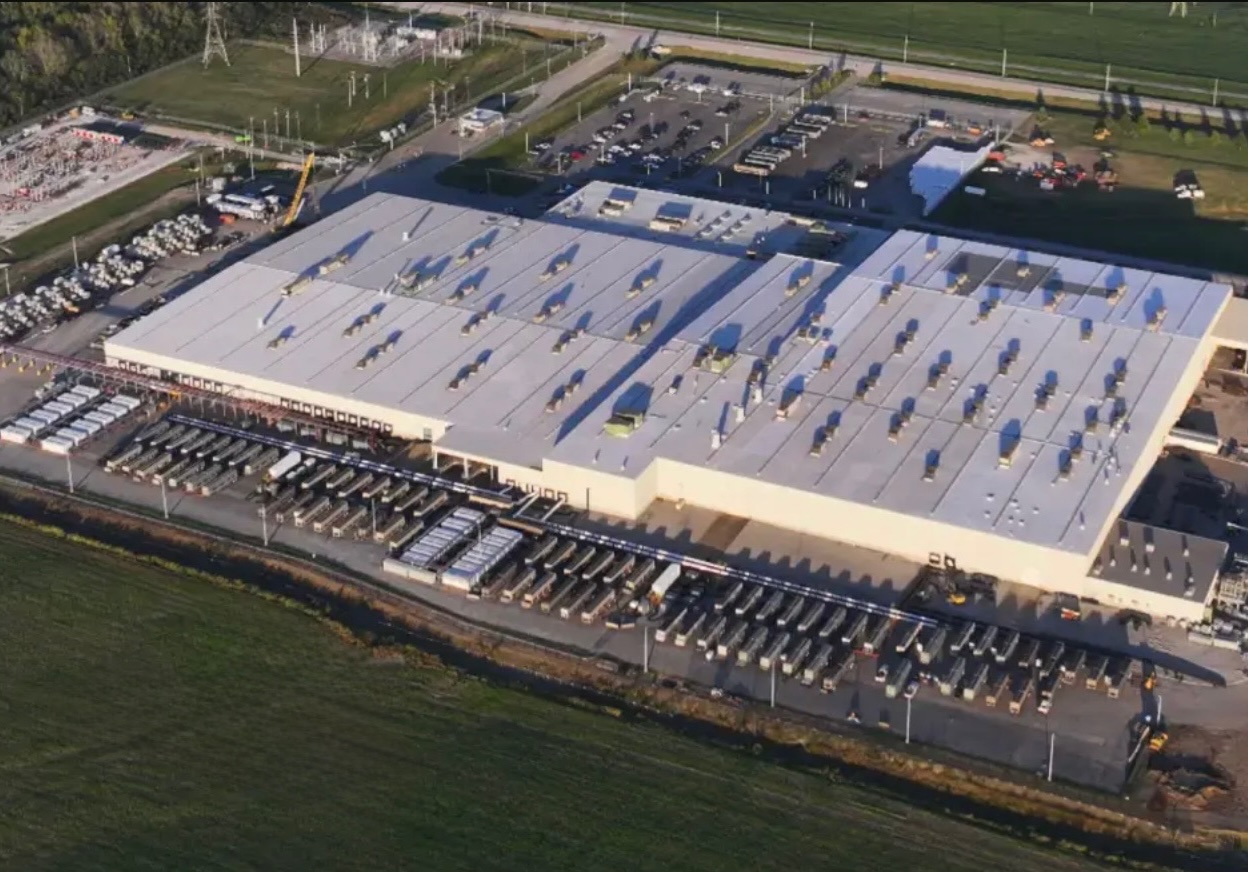
Elon Musk’s artificial intelligence startup xAI has secured an air permit from Memphis health officials for its data center project, despite critics’ opposition and pending legal action. The Shelby County Health Department approved the permit this week, allowing xAI to operate 15 mobile gas turbines at its facility.
Air permit granted
The air permit comes after months of protests from Memphis residents and environmental justice advocates, who alleged that xAI violated the Clean Air Act by operating gas turbines without prior approval, as per a report from WIRED.
The Southern Environmental Law Center (SELC) and the NAACP has claimed that xAI installed dozens of gas turbines at its new data campus without acquiring the mandatory Prevention of Significant Deterioration (PSD) permit required for large-scale emission sources.
Local officials previously stated the turbines were considered “temporary” and thus not subject to stricter permitting. xAI applied for an air permit in January 2025, and in June, Memphis Mayor Paul Young acknowledged that the company was operating 21 turbines. SELC, however, has claimed that aerial footage shows the number may be as high as 35.
Critics are not giving up
Civil rights groups have stated that they intend to move forward with legal action. “xAI’s decision to install and operate dozens of polluting gas turbines without any permits or public oversight is a clear violation of the Clean Air Act,” said Patrick Anderson, senior attorney at SELC.
“Over the last year, these turbines have pumped out pollution that threatens the health of Memphis families. This notice paves the way for a lawsuit that can hold xAI accountable for its unlawful refusal to get permits for its gas turbines,” he added.
Sharon Wilson, a certified optical gas imaging thermographer, also described the emissions cloud in Memphis as notable. “I expected to see the typical power plant type of pollution that I see. What I saw was way worse than what I expected,” she said.
-

 Elon Musk3 days ago
Elon Musk3 days agoTesla investors will be shocked by Jim Cramer’s latest assessment
-

 News1 week ago
News1 week agoTesla Robotaxi’s biggest challenge seems to be this one thing
-

 News2 weeks ago
News2 weeks agoTexas lawmakers urge Tesla to delay Austin robotaxi launch to September
-

 Elon Musk2 weeks ago
Elon Musk2 weeks agoFirst Look at Tesla’s Robotaxi App: features, design, and more
-

 Elon Musk2 weeks ago
Elon Musk2 weeks agoxAI’s Grok 3 partners with Oracle Cloud for corporate AI innovation
-

 News2 weeks ago
News2 weeks agoSpaceX and Elon Musk share insights on Starship Ship 36’s RUD
-

 News2 weeks ago
News2 weeks agoWatch Tesla’s first driverless public Robotaxi rides in Texas
-

 News2 weeks ago
News2 weeks agoTesla has started rolling out initial round of Robotaxi invites














